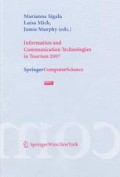Abstract
Virtual communities have revolutionized the way people interact and have important marketing implications as a viable business model, particularly in the tourism industry. Virtual travel communities (VTCs) in general provide service benefits sought by community members along with pleasurable VTC experiences. This is a challenging task, since multiple factors, social, psychological, and technology used, contribute to end users’ satisfaction with VTCs. This study examined experiences related by VTC members at different satisfaction levels in seven VTCs using CATPAC content analysis software. Implications for technology designers and virtual community managers are discussed.
Preview
Unable to display preview. Download preview PDF.
References
Allison, A., Currall, J. Moss, M. & Stuart, S. (2005). Digital Identity Matters. Journal of the American Society for Information Science and Technology, 56(4), 364–372.
Anderson, R. E., & Srinivasan, S. S. (2003). E-satisfaction and e-loyalty: a contingency framework. Psychology and Marketing, 20(2), 123–138.
Buhalis, D. (1998). Strategic use of information technologies in the tourism industry. Tourism Management, 19(5), 409–421.
Hagel, J., & Armstrong, A. (1997). Net gain: Expanding Markets through Virtual Communities, MA: Harvard Business School Press.
Jiang, H. (2005). An investigation of end users perception, attitude, trust and satisfaction with digital identity management in VTCs. Unpublished Master Thesis, Purdue University.
Kozinets, R. V. (1998). On netnography: initial reflections on consumer research investigations of cyberculture. Advances in Consumer Research, 25, 336–371.
Lawrence, T. B. (1995). Power and resources in an organizational community. Academy of Management Best Papers Proceedings, 251–255.
Mills, J. E., & Morrison, A. M. (2003). Measuring customer satisfaction with online travel. In proceedings of the International Federation of Information and Communications Technologies in Tourism 2003. Helsinki, Finland, January 27-February 1, 2003.
Nabeth, T. Understanding the Identity Concept in the Context of Digital Social Environments. INSEAD CALT-FIDIS working paper. http://www.calt.insead.edu/project/Fidis/. [Accessed on March 23, 2006]
Oliver, R. (1997). Satisfaction: A Behavioral Perspective on the Consumer. NY: McGraw-Hill.
Preece, J. (2000). Online Communities: Designing Usability, Supporting Sociability. Chichester: Wiley.
Rheingold, H. (1993). The Virtual Community: Homesteading on the Electronic Frontier. Reading, MA: Addison-Wesley Pub. Co.
Roberts, C. W. (2000). A conceptual framework for quantitative text analysis. Quality and Quantity, 34, 259–274.
Rothaermel, F. T., & Sugiyama, S. (2001). Virtual Internet communities and commercial success: individual and community-level theory grounded in the atypical case of TimeZone.com. Journal of Management, 27, 297–312.
Tonnies, F. (1967). Gemeinschaft and Gesellschaft. In C. Bell & H. Newby (eds.), The Sociology of Community, London: Frank Cass and Co. Ltd, 7–12.
Wang, Y., Yu, Q., & Fesenmaier, R. D. (2002). Defining the virtual tourist community: implications for tourism marketing. Tourism Management, 23, 407–417.
Weber, R. P. (1985). Basic content analysis. Beverly Hills, CA: Sage.
Wellman, B., & Gulia, M. (1999). Net surfers don’t ride alone: Virtual communities as communities. In P. Kollock, & M. Smith (Eds.), Communities and Cyberspace. New-York: Routledge.
Westbrook, R. A., & Oliver, R. L. (1991). The dimensionality of consumption emotion patterns and consumer satisfaction. Journal of Consumer Research, 18(1), 84–91.
Winer, R. S. (2001). A framework for customer relationship management. California Management Review, 43(4), 89–108.
Woelfel, J. K. (1998). CATPAC: Users guide. New York, N.Y.: RAH Press.
Author information
Authors and Affiliations
Editor information
Editors and Affiliations
Rights and permissions
Copyright information
© 2007 Springer-Verlag Wien
About this paper
Cite this paper
Stepchenkova, S., Mills, J.E., Jiang, H. (2007). Virtual Travel Communities: Self-Reported Experiences and Satisfaction. In: Sigala, M., Mich, L., Murphy, J. (eds) Information and Communication Technologies in Tourism 2007. Springer, Vienna. https://doi.org/10.1007/978-3-211-69566-1_16
Download citation
DOI: https://doi.org/10.1007/978-3-211-69566-1_16
Publisher Name: Springer, Vienna
Print ISBN: 978-3-211-69564-7
Online ISBN: 978-3-211-69566-1

